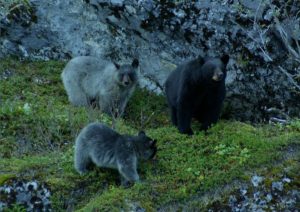Alaskan natives call them s’iknóon — the bear that disappears. These elusive animals, known to most as glacier bears, roam a remote patch of wilderness that covers portions of British Columbia, Yukon and Alaska. Many area guides have never seen one, even those who have spent decades in the habitat of the glacier bear.
The January/February 2019 edition of Canadian Geographic profiles what they describe as the “legendary and mysterious” glacier bear, including efforts to understand what makes them genetically different from their black bear cousins.
 Glacier bears have unique fur that ranges in color from a silvery blue-grey to charcoal-grey to black with silvery tips.
Glacier bears have unique fur that ranges in color from a silvery blue-grey to charcoal-grey to black with silvery tips.
The bears first show up in written records in 1882, noted for their “beautiful bluish under colour, with the tips of the long hairs silvery white.” That combination still catches attention today. HudsonAlpha Faculty Investigator Greg Barsh, MD, PhD, told the magazine, “The glacier phenotype really is unusual and not something scientists have seen in other animals.”
That rarity drives some of the curiosity that sparked an effort to genetically profile the bears. Tania Lewis and colleagues at the Alaska Department of Fish and Game with the help of a University of Calgary affiliate collected 284 black bear DNA samples, 22 of them belonging to glacier bears.
Barsh and his team back at HudsonAlpha are sequencing those samples. They’ve already sorted through dozens of genes associated with albinism or hair color in other species, but they have yet to find the gene or genes responsible for the unique coat of the glacier bear.
Identifying a piece of genetic code among tens of thousands of genes can be like searching for a needle in the haystack. Then again, perhaps that’s appropriate when it comes to understanding the bear that disappears.
Watch video of glacier bears in their natural habitat and read more from Canadian Geographic here.


